Orion, the Cathedral of the Sky
Posted by: bitacoradegalileo on: July 19, 2011
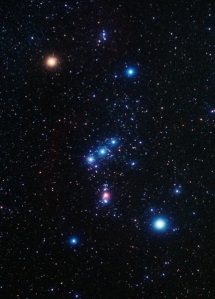 Orion is undoubtedly the most famous constellation in the sky of winter, and one of the best known among the 88 currently recognized by the IAU (International Astronomical Union). Its bright stars visible from both hemispheres make this constellation globally recognized and in my opinion the most fascinating. It has been called “The Cathedral of Heaven“, a name which I subscribe enthusiastically.
Orion is undoubtedly the most famous constellation in the sky of winter, and one of the best known among the 88 currently recognized by the IAU (International Astronomical Union). Its bright stars visible from both hemispheres make this constellation globally recognized and in my opinion the most fascinating. It has been called “The Cathedral of Heaven“, a name which I subscribe enthusiastically.
It is located right in the middle of the celestial equator, and is used as a reference for others, as we shall see. Orion resembles a person. First, try to locate the belt of Orion, 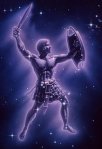 which consists of three bright stars in a straight line (Alnitak, Alnilam and Mintaka, from left to right). One of his legs is represented by a bright star called Rigel, which is one of thebrightest stars in the night sky. The other leg corresponds to the star Saiph. His two shoulders are the stars Bellatrix and Betelgeuse.
which consists of three bright stars in a straight line (Alnitak, Alnilam and Mintaka, from left to right). One of his legs is represented by a bright star called Rigel, which is one of thebrightest stars in the night sky. The other leg corresponds to the star Saiph. His two shoulders are the stars Bellatrix and Betelgeuse.  This last one is so bright that you can see its reddish color without the help of telescopes or binoculars, just the naked eye. A fainter star, Meissen, corresponds to the head. The whole is identified with the myth of the giant Orion, the hunter.
This last one is so bright that you can see its reddish color without the help of telescopes or binoculars, just the naked eye. A fainter star, Meissen, corresponds to the head. The whole is identified with the myth of the giant Orion, the hunter.
The other stars of the constellation with proper name are Tabit (the shield), and Hatysa (the sword), also called Nair Al Saiph.
MAIN STARS
The brightest stars of the constellation are Rigel, Betelgeuse, Bellatrix, Alnilam, Alnitak,Saiph, Mintaka and Hatysa, in that order. These stars are at different distances from us,and their form in space is only a flat projection, which from another point of view would appear quite different, ruining all the rivers of ink spilled about the shape the constellation.

We will stop briefly at each of these luminaries:
Rigel is the star Beta Orionis. Although its designation of Bayer “Beta” should correspond to the second brightest star in the constellation, its apparent magnitude of+0.18 indeed places it as the brightest of it ahead of Betelgeuse  (Alpha Orionis) being the fifth brightest all over the night sky. According to estimates by Hipparcos satellite , its distance from the Sun is about 860 light-years. This is a triple star system whose main component is a blue-white supergiant with a surface temperature of 11,500 ° K. Glows with a brightness in the visible spectrum over 50,000 times of the Sun’s and of 85,000 suns in bolometric scale. Its radius is equal to 84 times our star, so if it were in the place of the Sun, it would extend to the orbit of Mercury.
(Alpha Orionis) being the fifth brightest all over the night sky. According to estimates by Hipparcos satellite , its distance from the Sun is about 860 light-years. This is a triple star system whose main component is a blue-white supergiant with a surface temperature of 11,500 ° K. Glows with a brightness in the visible spectrum over 50,000 times of the Sun’s and of 85,000 suns in bolometric scale. Its radius is equal to 84 times our star, so if it were in the place of the Sun, it would extend to the orbit of Mercury.
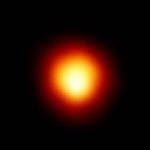 Betelgeuse, also called Alpha Orionis, is a beautiful red star, the ninth brightest in the sky, big and bright, for it is a red supergiant. The characteristic color of this star comes from the lowsurface temperatures, 3,000 ° K. It is a variable star, and its maximum size would extendbeyond the orbit of Mars. It is about 800 times larger than the Sun. It is located about 650 light years from the Solar System and its visual magnitude is between +0.5 and+1.3.
Betelgeuse, also called Alpha Orionis, is a beautiful red star, the ninth brightest in the sky, big and bright, for it is a red supergiant. The characteristic color of this star comes from the lowsurface temperatures, 3,000 ° K. It is a variable star, and its maximum size would extendbeyond the orbit of Mars. It is about 800 times larger than the Sun. It is located about 650 light years from the Solar System and its visual magnitude is between +0.5 and+1.3.
Bellatrix (Gamma Orionis) is the third brightest star in the constellation, with apparent magnitude +1.64. Bellatrix’s name, the Amazon Star, comes from Latin and means “warrior.” It is a blue giant with a surface temperature of 21,500 K, one of the hottest stars you can see at a glance. It is6400 times brighter than our Sun, and 5.7 times larger than this. It is situated about 250light years from us.
Alnilam (Epsilon Orionis) is, with apparent magnitude +1.7, the fourth brightest star in Orion. This is the central star of the Belt, and the brightest of the three, despite being the farthest, about 1340 years-years away. It is a blue supergiant, whose brightness is extraordinary, equivalent to about 375,000 times the luminosity of the Sun. Alnilam is very hot, about 25,000 K and its diameter is 31 times the Sun’s.
Alnitak (Zeta Orionis) is a triple star system also part of Orion’s Belt. The main component is a blue supergiantof apparent magnitude +1.89, located about 800 light-years from Earth. It is very hot,about 31,000 K, and its mass is estimated at about 20 solar masses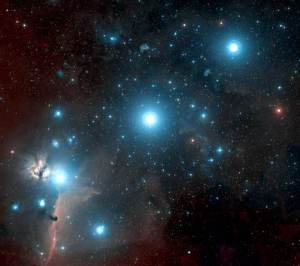 .
.
Saiph (Kappa Orionis) is the sixth brightest. Has a magnitude of +2.06 and is located about 720 light-years away. With a surface temperature of 26,000 K, is a blue supergiant with a radius 11times the solar radio.
Mintaka (Delta Orionis) is the third of the stars in the Belt, and the faintest of them, with a magnitude of +2.23jointly, because it is a complex multiple star. It is is a blue star at 915 light years and has a temperature of 30,000 ° K. Its mass is equivalent to 20 suns.
Hatysa (Iota Orionis) is found in the Sword of Orion, and with a magnitude of +2.75 is the brightest of which make said sword. Also known as Na’ir to Saif. No one knows the distance that it is located, speculating with numbers ranging from 1300 to 2000 light-years away. It is a blue giant that is 31,500 ° K temperature, i.e. more than 25,000 K hotter than the Sun. Its mass is equal to 15 times our star.
M42: THE GREAT NEBULA IN ORION.

In the center of the Sword of Orion, below the belt is distinguished, with the naked eye, adiffuse spot sometimes confused with a star. It is the object of Charles Messier’s catalog number 42, M42, known as the Great Nebula of Orion. It is a diffuse nebula, one of the brightest that exist, which can be seen without optical aid. Located around 1,500 light years from us, has a diameter of about 30 light-years. At first sight appears blurry, but with simple telescopes, or simply with binoculars it can be seen quite clearly . Optical images show that this is a huge cloud of gas and dust. Contains within newly formed stars, interstellar clouds, star clusters, H II regions Hydrogen (ionically active) and reflection nebulae. The little cloud that appears torn at the top is the De Marian’s nebula , or M43. Several factions of the nebula have their own name. The dark path that extends from the north to the bright region called the Fish’s Mouth, and the light regionson both sides are called Wings.
. Optical images show that this is a huge cloud of gas and dust. Contains within newly formed stars, interstellar clouds, star clusters, H II regions Hydrogen (ionically active) and reflection nebulae. The little cloud that appears torn at the top is the De Marian’s nebula , or M43. Several factions of the nebula have their own name. The dark path that extends from the north to the bright region called the Fish’s Mouth, and the light regionson both sides are called Wings.
In this picture we see the Trapezium cluster, named for the asterism of its four main stars. These stars, between 5th and 9th magnitude, can be solved easily with a telescope of 80 mm opening. They are very young stars, just formed.
REGION ALNITAK

Alnitak (Zeta Orionis) is, may not be amiss to remember, the star to the left on the Belt of Orion. In the vicinity are two interesting deep sky objects: the Flame Nebula and Horsehead Nebula. The photograph shows Alnitak, the brightest star, and just below is the Flame Nebula, which gets its name from its appearance of being on fire.The bright star located at the top right is Sigma Orionis
 (doesn’t have a proper name), and at the center is the Horsehead, a spectacular dark nebula of which, on the left, we provide a detail.
(doesn’t have a proper name), and at the center is the Horsehead, a spectacular dark nebula of which, on the left, we provide a detail.
The Great Nebula in Orion is a very popular object for amateur astrophotographers. It takes an apparent extension in the sky of over 60′ of arc.
The Constellation of Orion and Sirius.
In the following paragraphs we will use the stars of the constellation Orion, already known, to locate other significant stars and constellations in the night sky in the winter,southern summer. We will do this using graphics that reproduce quite accurately the situation, regarding our constellation, of the stars that we are going to find. We will do this by drawing an imaginary line from Orion to the star in question.
This first scheme recreates the picture above, and shows how, extending to the left the line connecting the three belt stars, we come easily to the proximity of Sirius (Alpha Canis Maioris), which is the brightest star in the entire night sky, then there will be no difficulty in locating the rest of the components of Canis Maior (Greater Dog). The inhabitants of the Southern Hemisphere should be aware that his view differs from the Boreal by 180 °.
extending to the left the line connecting the three belt stars, we come easily to the proximity of Sirius (Alpha Canis Maioris), which is the brightest star in the entire night sky, then there will be no difficulty in locating the rest of the components of Canis Maior (Greater Dog). The inhabitants of the Southern Hemisphere should be aware that his view differs from the Boreal by 180 °.

In this one, we have treated the scheme just the opposite, joining the line of three stars in the belt extending towards the right, just to the vicinity of Aldebaran (Alpha Tauri), a beautiful red giant star which is the principal in the constellation Taurus. A little further we appreciate the open star cluster M45, the magnificent Pleiades, which will be our next work. With regard to the Southern Hemisphere, we must make the same observation we made at the time of the previous scheme.
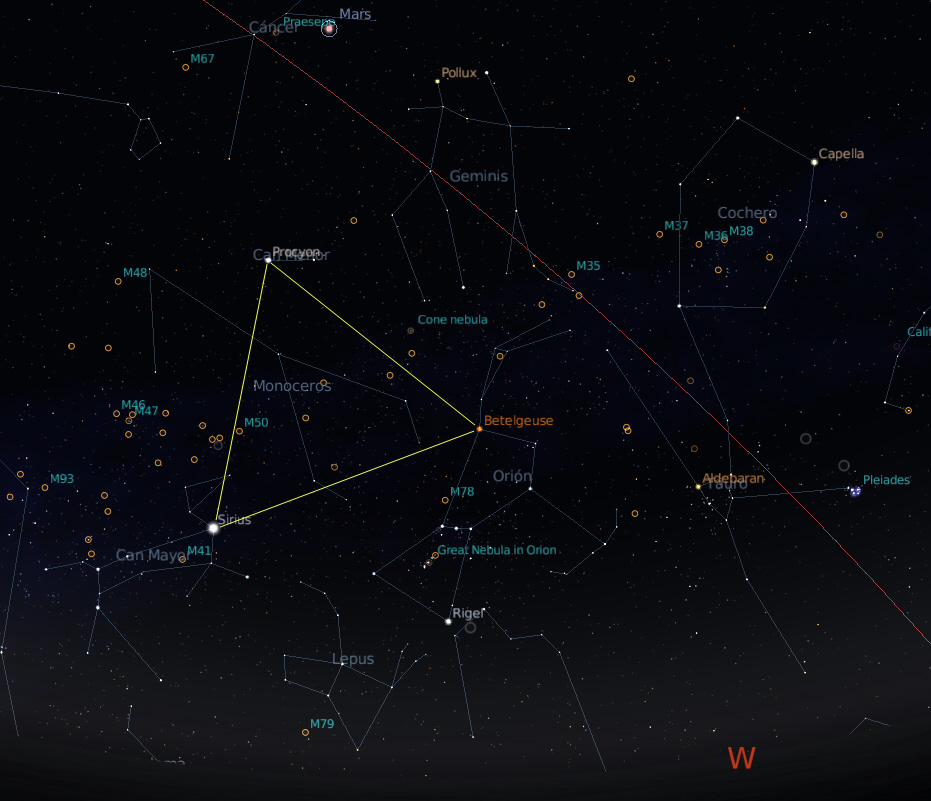 Finally, inasmuch as we already know the location of Betelgeuse, and have just learned to locate Sirius, we will use these two stars in the sky to build an imaginary equilateral triangle, that is called the Winter Triangle, whose third vertex will be Procyon , a very brilliant star, which is the main member of the constellation of Canis Minor (the Lesser Dog). There is also a Summer Triangleformed by Vega, Altair and Deneb.
Finally, inasmuch as we already know the location of Betelgeuse, and have just learned to locate Sirius, we will use these two stars in the sky to build an imaginary equilateral triangle, that is called the Winter Triangle, whose third vertex will be Procyon , a very brilliant star, which is the main member of the constellation of Canis Minor (the Lesser Dog). There is also a Summer Triangleformed by Vega, Altair and Deneb.
Using these and other little tricks, we can go gradually placing the constellations and principal stars, thereby increasing our knowledge of Heaven and Outer Space without effort, but with love and dedication.
MYTHOLOGY
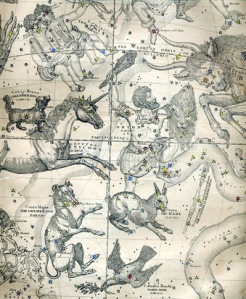
Orion was the son of Poseidon, god of the sea, and Gaia, Mother Earth. He had an extraordinary beauty and grew so much that became a genuine giant. So enormous he was he could walk along the bottom of the deep sea waters without ever cover him from the shoulders up.
After many adventures, Orion went to the island of Chios, where soon later fell in love with Merope, the daughter of King Oenopion. Such was his love for her that sought her in marriage. Oenopion consented, but first demanded the giant to prove his courageperforming a difficult mission. Orion would have to kill a large number of pests that were causing huge losses to crops on the island. When he had exterminated all the vermin, the monarch refused to keep his promise.
Orion tried to take revenge on Oenopion, but could not find him because he took refuge in a subterranean chamber so convoluted,that it was practically Inscrutable. Then, Orion set up even more in anger and, in rage, he felt like killing with his infallible arrows and mercilessly all the animals that were going out to meet, whether gentle or fierce animals and innocent creatures. Such was the number of casualties he had caused already that his mother Gea had to intervene asking, without success, that he was kind and thoughtful. Orion ignored the words of his mother and sticked to his guns, despite the repeated warnings from Gea.
One day, when the proud giant was meeting with friends, conceited that neither tigers or panthers, or even lions or snakes were able to produce any awe, overwhelmed the patience of his mother, who sent a very poisonous scorpion. Orion, when he saw it,was unable to contain his ironic smile at the ridiculousness of this insignificant adversary sent by Gaia.
 The giant relied too much and the scorpion stung him in the foot with its powerful poisonous sting. The terrible venom spread through the blood of the hunter and he fell down half dying. When he saw that death was imminent, asked for help and beggedZeus almighty for vengeance, as death was stalking him ingloriously for a character in his mood. He asked the supreme God toput him in heaven with his two faithful hunting dogs (Canis Major and Canis Minor) and a hare (Lepus), so that, when men look upin the dark starry nights, remember his adventures as a hunter. Also requested Zeus the domain of tempests, storms, ice and winds, to be able to take avenge on his mother Earth (Gaia).
The giant relied too much and the scorpion stung him in the foot with its powerful poisonous sting. The terrible venom spread through the blood of the hunter and he fell down half dying. When he saw that death was imminent, asked for help and beggedZeus almighty for vengeance, as death was stalking him ingloriously for a character in his mood. He asked the supreme God toput him in heaven with his two faithful hunting dogs (Canis Major and Canis Minor) and a hare (Lepus), so that, when men look upin the dark starry nights, remember his adventures as a hunter. Also requested Zeus the domain of tempests, storms, ice and winds, to be able to take avenge on his mother Earth (Gaia).
The god was condescending with Orion and his supplications were attended. The earth trembled, and since then it has been doing to this day every time Orion has been seen above the firmament, as he has always brought the wind, the cold, the storms, the ice, the snow and the frost which are so abundant on Earth in winter, coinciding with the arrival of this constellation.
Zeus was also responsible of placing the Scorpion (Scorpius) in the sky, but was careful to place it as far away from the giant so they would never ever face. So, when Orion disappears from the sky it is when Scorpius appears. While Orion appears in winterScorpius does in the summer.
ORION IN THE HISTORY OF CIVILIZATIONS
The Egyptians saw the constellation Orion as the god Osiris holding in his hands the star Aldebaran, or Alpha Tauri.
Isis is represented as the star Sirius, the brightest in the sky and that we see in the skies from November through March. To the Egyptians their calendar began when they observed Sirius in its output or rising shortly before sunrise, a phenomenon that occurred in June and by the precession of the equinoxes is now produced in late August and involved the flooding of the Nile, fundamental for the control and development of Egyptian civilization.
 Some fragments of the Pyramid Texts say that the soul of Pharaoh would become a star in Orion:
Some fragments of the Pyramid Texts say that the soul of Pharaoh would become a star in Orion:
“In your name of Inhabitant of Orion, a season in heaven and a season on earth”
(Pyramid Texts 187).
“Oh king, you’re the great star, the companion of Orion, who runs through the sky with Orion, you navigate the Duat [underworld] withOsiris, thou ascend from the eastern sky being renewed in your due time and rejuvenated your due time. The heaven has beenwith Orion”
(Pyramid Texts 882-3).
In the book of the Bible, Orion is mentioned at least three times, two of them in the Book of Job.
“He is the maker of the Bear, Orion, and the Pleiades, And the chambers of the south”, Job 9:9.
“Can you bind the chains of the Pleiades or loose the cords of Orion?”, Job 38:31.
And in the Book of Amos 5:8.
Especially in the modern age, through technological creation humanity has been able to see great detail in the sky. Thus, the Hubble Space Telescope, Astronomical Eye Site, its creators have received wonderful scenes like the Orion Nebula or the Horsehead Nebula.
The following illustration is taken from the book “The Orion Mystery” by Adrian Gilbert. The picture depicts a scene in which “the Messenger” gets a ray from the “Portal” of Gemini while St. John wrote the Book of Revelation.
“Opening of the Stargate: 29th June AD 2000″ .
Painting by Bengt Alfredson.

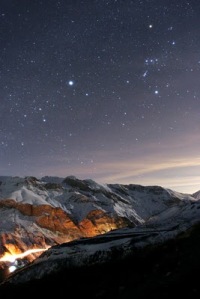
Leave a Reply